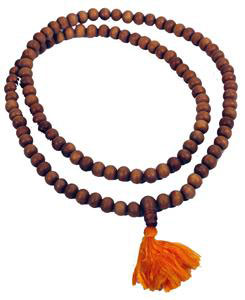
Mala ou tengwa, le rosaire du Bouddhiste
A japa mala or mala is an eastern rosary with 108 beads. The mala is used both in Hinduism and Buddhism for counting mantras, chants or prayers. Buddhist rosaries were likely adapted from Hinduism.
Malas are used especially in esoteric Japanese and Tibetan Buddhism, in which they are worn by priests and devotees alike. Rosaries are also the attributes of certain deities, most notably Avalokiteshvara, the bodhisattva of compassion.
Materials
Buddhist rosaries are made from a variety of materials, most commonly wood. Preferred woods are sandalwood or sacred wood from the bodhi tree.
More expensive rosaries are made of precious and semi-precious stones, including pearls, rubies, crystal, amber, coral, or jade, or precious metals such as gold. They can also be made of seeds, animal bone (most commonly yak), and sometime even human bone (see skull cups).
The string that holds the beads together is usually made of silk, but is sometimes made of human hair. In Buddhist Tantra or Vajrayana, materials and colors of the beads can relate to a specific practice.
Number of Beads
Traditionally, Buddhist have 108 beads, representing the 108 human passions that Avalokiteshvara assumed when telling the beads. This number also ensures the worshipper repeats the sacred mantra at least 100 times, the extra beads allowing for any omissions made through absentmindness in counting or for the loss or breakage of beads. Malas of 111 beads are also common, and derive from this same idea.
A lesser number of beads is also seen in various forms of Mahayana Buddhism, usually a number divisible by three. In Pure Land Buddhism, for instance, 27 beads rosaries are common. Many Chinese rosaries have only 18 beads; one for each of the 18 lohans.
Before being knotted, the string is passed through a large central bead and two smaller beads. These three additional beads keep the rest in place and indicate the completion of a cycle of mantras. They also symbolize the Three Jewels of Buddhism: the Buddha, the dharma, and the sangha. The hidden string that passed through all the beads symbolizes the penetrating power of the Buddhas.
Functions and Uses of Buddhist Prayer Beads
Mantras are often repeated hundreds or even thousands of times. The basic function of the mala is to allow one to think about the meaning of the mantra as it is chanted without having to also concentrate on counting the repetitions. Each time the mantra is repeated, the fingers move to the next bead.
Prayer beads are generally worn as bracelets, usually by followers of the Japanese and Tibetan esoteric schools of Buddhism. But priests often carry longer strings of beads as necklaces. Many paintings of important Buddhist priests or patriarches show them seated on a platform wearing robes and handling rosaries.
According to Hindu tradition, the correct way to use a mala is with the right hand, with the thumb flicking one bead to the next, and with the mala draped over the middle finger. The index finger was considered rude, and so was also considered bad to use it with a mala.
Buddhism, however, taught that it was perfectly acceptable to use the mala in the left hand with any fingers. In Tibetan Buddhism, depending on the practice, there may be preferred ways of holding the mala (left or right hand, rolling the beads over the index or any of the other fingers, etc.).
Very large rosaries are sometimes used as rituals dedicated to particular deities. For example, a ritual is held each summer in Kyoto in which children sit in a circle and pass around a large rosary to invoke the protection of the bodhisattva Kshitigarbha, guardian of children in Japan.
Rosaries in Buddhist Art
As mentioned above, prayer beads are the attributes of certain Buddhist deities. Avalokiteshvara is often depicted holding a lotus, a water sprinkler, and a rosary of 108 beads, representing the bodhisattva’s wish to help believers conquer the 108 passions and attain enlightenment.
The compassionate buddha Amitabha is also sometimes depicted holding a rosary. Wrathful deities are sometimes shown holding rosaries made of skulls.
Terms and Etymology
Mala is a Sanskrit word. In Chinese, the rosary is nianzhu; in Japanese, nenju; in Vietnamese, tranghat. The most common English translations are “rosary” or “prayer beads.”
The English word “rosary” may have come from the Sanskrit japa mala. When Roman explorers came into India and encountered the mala, they heard jap mala, and jap for the Romans meant “rose.” Thus when the mala was carried back to the Roman Empire as rosarium, and into English as “rosary.”
Source
- Meher McArthur, Reading Buddhist Art: An Illustrated Guide to Buddhist Signs and Symbols (Thames & Hudson, 2004), 149.
- “Mala.” Wikipedia, 2005. en.wikipedia.org
source: www.religionfacts.com




